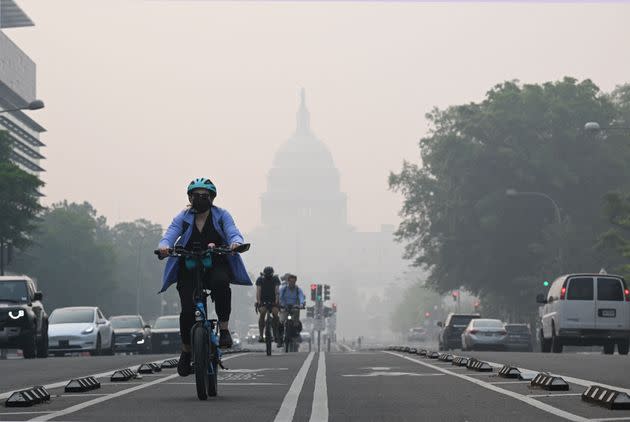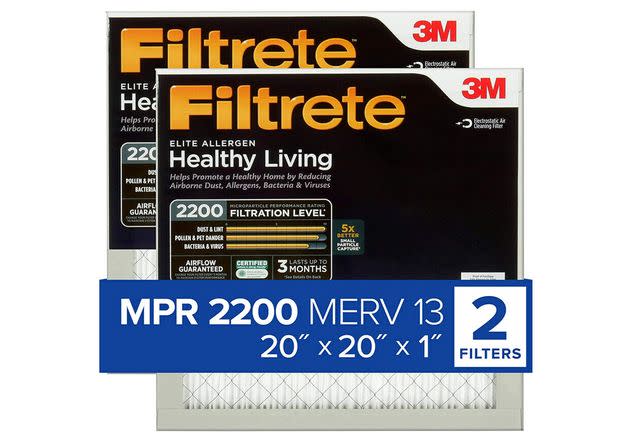This One Type Of Air Conditioner Filter Can Actually Filter Smoke From Your Home

A cyclist rides under a blanket of haze partially obscuring the U.S. Capitol in Washington, D.C., on June 8. Smoke from Canadian wildfires has shrouded the East Coast.
If you’re in the northeast, southeast or midwestern United States, you may feel like you’re living in a cloud of smoke at the moment, complete with a campfire scent, gray skies and an eerie orange hue lighting up your home. Due to wildfires in Canada, many parts of the U.S. are experiencing very poor air quality right now. And for many people, this can pose major health hazards.
Wildfire smoke consists of a mix of gases and fine particles from burning vegetation, building materials and other matter. Wildfire smoke is toxic, and can make anyone sick, but it’s particularly hazardous to certain at-risk populations, such as kids, older adults, people with asthma and other respiratory conditions, and pregnant people.
Staying indoors ― and wearing an N95 mask when you have to go outside ― are great ways to protect yourself. But you can also make changes to the air quality in your home by using a certain type of high-efficiency air filter with your air conditioning system. In fact, a really good one can remove as many as 95% of the harmful particles that pass through it.
So, what are your best options when it comes to home AC filters to keep your air as safe and clean as possible? Here’s everything you need to know.
There’s one specific type of air filter to look for if you want to filter out wildfire smoke in your home

A 3M Filtrete air filter with MERV 13 capabilities. Whatever brand you buy, be sure to check the dimensions of your old filter first. (They're typically printed on the sides of the filter.)
Dr. John McKeon, a medical doctor and CEO of the international standards certification company Allergy Standards Limited, recommends looking for HVAC filters with a Minimum Efficiency Reporting Value rating of 13 or above ― which you’ll see listed as “MERV 13” in product descriptions.
“These filters have been independently tested and confirmed to effectively remove air pollution and other asthma triggers,” McKeon said. “Additionally, we advise seeking filters that carry the ‘CERTIFIED asthma & allergy friendly’ mark, as they meet specific standards for allergen reduction.”
To earn this certification, McKeon explained, HVAC filters must meet strict standards that assess their effectiveness in removing allergens and irritants from the airflow, monitor fiber shedding during use, and analyze the quality of the seals.
“These standards ensure that the filters are capable of providing a high level of filtration and maintaining their performance over time,” he said.
McKeon suggests looking at the brand 3M Filtrete, which has a MERV 13 option in many standard sizes, has the asthma & allergy-friendly certification, and is affordable and available on Amazon.
That said, if you can’t find an air filter with a MERV 13 rating or above, medium-efficiency filters (MERV 5-8) or high-efficiency filters (MERV 9-12) are better than nothing. Make sure to change the filter every few weeks until air quality improves. The dirtier the air, the more often you’ll need to change the filter to keep your system running in top form.
The EPA notes that most HVAC systems can accommodate a MERV 13 filter without mechanical issue, provided the filter is frequently replaced. If you’re not sure your system can handle a MERV 13 filter ― the agency notes that a lot of HVAC systems aren’t labeled with filter recommendations — you can check with a professional HVAC technician.
How MERV 13 filters actually work
If you’re wondering how these air filters work, the explanation is pretty simple: Air filters with a MERV rating of 13 or above work by capturing and trapping particles in the air as it passes through the filter.
“The higher the MERV rating, the more efficient the filter is at removing smaller particles, including those found in wildfire smoke,” McKeon said. “These filters consist of densely-packed fibers or pleats that create a barrier, allowing clean air to pass through while capturing and retaining harmful particles.”
Even when the smoke dies down, smoke and particles can linger in the air, said Jennie Bergman, an indoor air quality expert at Trane Residential, a company that manufactures home heating and cooling systems.
“For that reason, it is important for everyone to evaluate their filter options to protect your family’s health,” Bergman said. “If you or a family member are having allergy or asthma symptoms, first talk to your health care provider. During poor air quality events, it is also recommended to set your HVAC fan to run continuously and seal windows that may let outdoor pollens, allergens, or harsh toxins into your home.”
Unfortunately, climate change will continue to bring more fires — and because of that, it’s important to be as prepared as possible to deal with unhealthy air quality. Because we spend 90% of our time indoors (and more when the air quality is poor!), investing in the right air filters is a great place to start.
HuffPost may receive a share from purchases made via links on this page. Every item is independently selected by the HuffPost Shopping team. Prices and availability are subject to change.

 Yahoo Sport
Yahoo Sport 





































